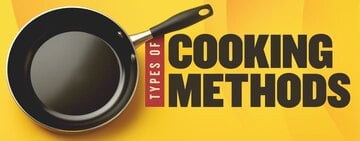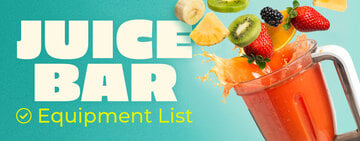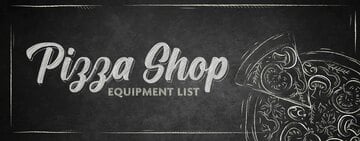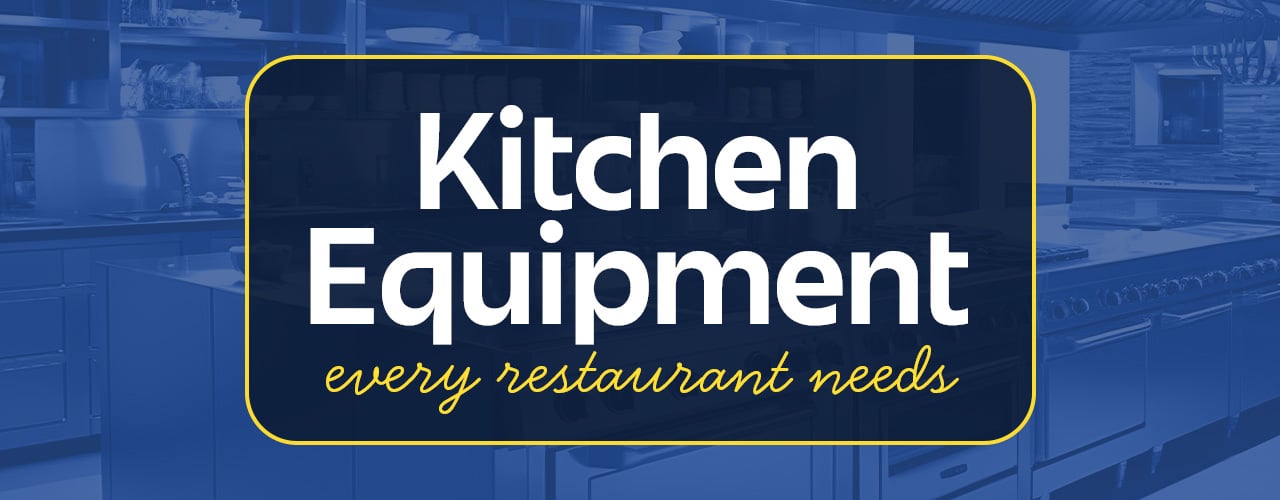
Kitchen Equipment Every Restaurant Needs
Last updated on 2/2/2024Selecting the appropriate restaurant kitchen equipment is crucial for success when opening a new restaurant or renovating your existing business. Depending on your type of restaurant, you might need to invest in fine china or extra deep fryers. We compiled a comprehensive list of essential restaurant equipment to provide a starting point for equipping your kitchen. Though this list serves as a foundation that encompasses the staples nearly every restaurant needs, you can expand it to meet your unique requirements.
Download Equipment List PDF1. Cooking Equipment
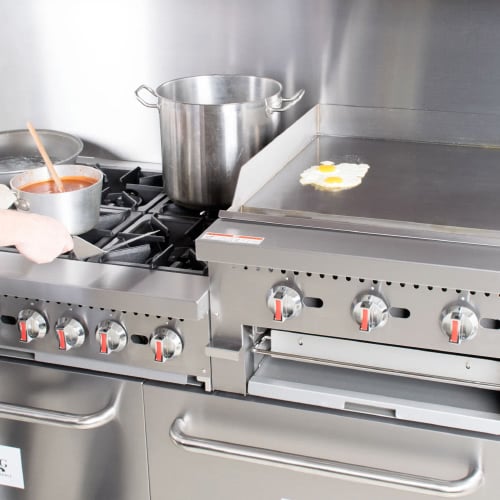
Cooking equipment is the cornerstone of any commercial kitchen regardless of the type of restaurant. When choosing cooking equipment for your restaurant, consider what items you use the most. While smaller pieces of equipment may be less expensive, they may not meet your capacity needs if you use them regularly, costing your business more in the long run. You may also need additional gas hoses and other components to install your cooking equipment successfully.
- Oven: As one of the most vital pieces of cooking equipment, use your oven for baking, roasting, braising, and much more. There are various types of ovens to consider, ranging from pizza ovens to combi ovens.
- Range: A range combines a cooktop and an oven into one appliance, allowing you to bake, sautee, boil, roast, or broil items. You can choose an electric or gas range depending on your needs and kitchen setup.
- Deep Fryer: Use deep fryers to make customer favorites, like french fries and chicken tenders, or to deep-fry a turkey.
- Grill: Charbroilers and other grills add a smoky, charred flavor perfect for meat and vegetables.
- Griddles: With a flat metallic surface, griddles allow chefs to scramble eggs, craft the perfect Philly cheesesteak, or grill a burger.
- Holding Equipment: Holding cabinets keep your food at a specific temperature, which makes them ideal for holding food until it's ready to serve or proofing breads before baking.
- Salamander or Broiler: Use a salamander or broiler to finish dishes, toast bread, or melt cheese. They also have sufficient heat output to broil salmon or cook foods.
- Toaster: If you plan to open for breakfast, a commercial toaster is a crucial addition to your kitchen for serving bread and bagels.
- Microwave: Microwaves are a convenient way to heat sauces, defrost frozen foods, and reheat products.
2. Beverage Equipment
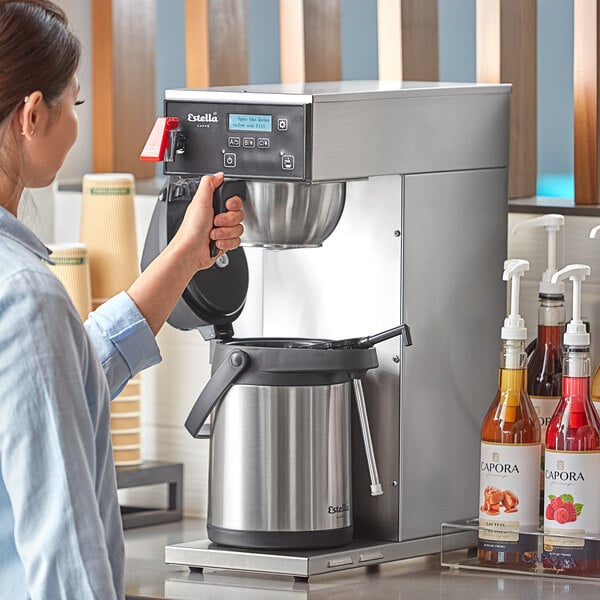
Serving drinks is just as important as filling food orders. If you own a coffee shop, bar, or juice bar, these appliances are the backbone of your operation. However, standard restaurants still need the following beverage equipment items to accommodate their customers.
- Coffee Brewer: Coffee is a popular beverage, making a basic coffee brewer a necessity even if you're not opening a cafe or bakery.
- Beverage Dispensers: Some establishments, like fast food and fast casual restaurants, may have self-service beverage dispensers, while others may have them at wait stations. When choosing a dispenser, consider which brand and how many soft drink options you want to serve.
- Ice Machine: Ice machines are a vital beverage service component at any restaurant, cafe, or bar to keep drinks cold when you serve them. Businesses with a beverage-focused operation may use ice to make smoothies or blended cocktails.
3. Refrigeration Equipment
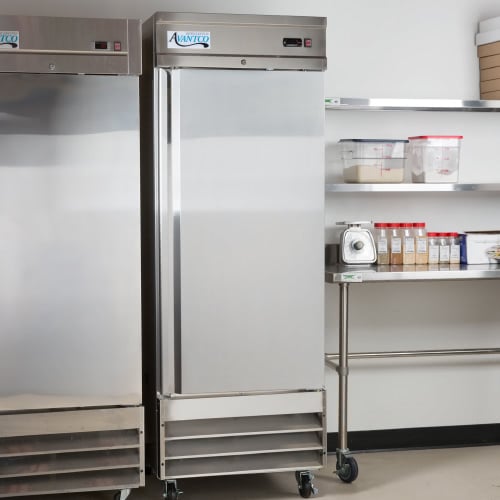
There are many different styles of refrigeration equipment, and your preferred option will depend on your type of restaurant and your specific refrigeration needs. Whether you choose a reach-in model or undercounter unit, an excellent refrigerator and freezer will be the cornerstone of your kitchen.
- Refrigerator: Some common types of refrigerators include walk-in coolers, reach-in fridges, pass-through options, or prep fridges. Your restaurant will likely require a combination of different types.
- Freezer: Like refrigerators, freezers come in various sizes and styles to suit your needs and food capacities. Use proper cold storage practices to avoid cross-contamination.
4. Storage Equipment
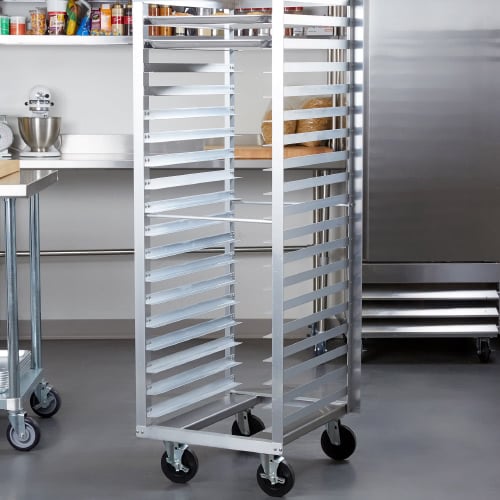
Storage equipment keeps your kitchen and workspaces tidy, increasing productivity and reducing workplace accidents. As you purchase and use these items, follow proper food storage guidelines to ensure food safety.
- Shelving: Use shelving in your walk-in cooler or freezer to store different foods, or place it in the kitchen to keep pots, pans, dinnerware, and dry ingredients accessible. Shelving comes in various sizes and configurations, allowing you to customize your shelving for your space.
- Bussing and Utility Carts: Bussing and utility carts are handy in all areas of kitchen operation. Utilize them in the front-of-house area for bussing tables or in the back-of-house area for moving heavy equipment or ingredients.
- Sheet Pan Racks: Sheet pan racks can store and transport foods, but you can also use them for holding and proofing bread. Sheet pan racks are tall rather than wide, so they don't cover valuable counter space in cramped kitchens.
- Food Storage Containers: Food storage containers are the perfect multi-purpose tools for storing prepped ingredients, mixing sauces and stocks, or holding dry items like pasta or rice. Many containers come with colored lids or markings for easy organization.
- Drying Racks: Drying racks provide a place to store and air-dry dinnerware, glassware, cookware, cutting boards, and utensils.
- Dunnage Racks: Dunnage racks also dry equipment, but they sit only a few inches off the floor for increased stability. Use them for heavy items such as canned goods, rice, or large appliances.
5. Food Prep Equipment

Restaurants have different requirements for food prep equipment depending on their recipes. However, most foodservice establishments use a few key items to increase the efficiency of their kitchen.
- Food Processors: These versatile appliances can help reduce valuable prep time. Use them to make sauces, combine ingredients, chop vegetables, and slice cheese.
- Prep Tables: Place appliances and equipment on these sturdy prep tables or use them as a surface for prepping ingredients or assembling dishes.
- Mixers: While bakeries and pizza shops might use commercial mixers most frequently, every restaurant can use this appliance to increase efficiency in food preparation.
- Spice Grinders: While using pre-ground spices is economical, freshly ground spices and herbs have a unique flavor that can give your recipes more depth.
- Blenders: Most commonly found in bars and cafes, blenders have many uses ranging from mixing drinks, combining sauces, or creating marinades.
6. Smallwares

Smallwares, also known as cookware, are tools used in the kitchen to prepare and cook your dishes. Carefully consider the quantity of each item when ordering smallwares for your new kitchen, so your employees aren't fighting for the same tool.
- Chef Knives: A sharp set of knives is the most important smallware in a kitchen. They make food prep easier and decrease the risk of accidents and cuts.
- Cutting Boards: There are many types of cutting boards available with different materials that lend themselves to specific tasks. Make sure you color code your cutting boards to prevent cross-contamination and follow HACCP guidelines.
- Mixing Bowls: Purchase multiple sizes of mixing bowls for different applications, such as blending batter or whisking eggs.
- Pans: There are many kinds of pans, such as sauce, saute, braising, and fry pans. Consider which types and how many your kitchen needs before placing your order.
- Pots: Similar to pans, there are multiple types of pots, such as stock pots, double boilers, pasta cookers, sauce pots, and more specialized options.
- Whisks: Whisks are valuable tools that incorporate air into your ingredients, giving them a light and fluffy texture. You can also choose from the different types of whisks for the one that best suits your needs.
- Food Pans: Prepare dishes in the oven in food pans or use them to hold food in a food warmer until it's ready to serve. Food pans are especially crucial for caterers and buffets when transporting and serving food.
- Kitchen Spoons: Stir sauces in the back-of-house area, serve foods at your buffet, or remove ingredients from a bowl with various types of kitchen spoons. These versatile tools should be on every restaurant equipment list.
- Turners: If your restaurant or diner uses griddles, charbroilers, or grills, turners protect your staff from burns. Choose turners with high-heat handles to keep your employees' hands safe.
- Tongs: Tongs have a lot of utility, and you can use them for food prep, plating, or serving purposes, depending on your needs.
7. Janitorial Equipment

Cleanliness is paramount in the foodservice industry, so your new business needs a stock of janitorial equipment and cleaning supplies. Different restaurants may require various cleaning supplies depending on their appliances and flooring, but there are a few universal necessities.
- Microfiber Cloths and Cleaning Rags: Microfiber cloths and rags have many uses in restaurants, from cleaning up spills, wiping down tables and chairs, polishing glassware, and more.
- 3 Compartment Sink: Use 3 compartment sinks to clean and sanitize your products completely and follow health codes. In addition to your compartment sink, you'll also need to invest in a grease trap and a commercial faucet.
- Foodservice Chemicals and Sanitizers: Choose the right chemicals for cleaning your commercial equipment, and don't forget sanitizing chemicals that keep your products safe.
- Trash Cans and Recycling Bins: Every establishment needs a place to dispose of their trash, so place trash cans and recycling bins strategically throughout your establishment.
- Mops and Mop Buckets: Mopping your floors at the end of the day helps clean up any spills and messes that accumulate during service.
- Wet Floor Signs: Wet floor signs alert customers and employees to take caution when walking on slippery floors.
- Scrubbers and Sponges: Order a variety of scrubbers and sponges with different abrasiveness so you have heavy-duty options for stuck-on messes or soft sponges for cleaning delicate items.
- Restroom Supplies: Stock up on restroom supplies like toilet paper, paper towels, hand soap, urinal cakes, and baby changing tables.
- Brooms and Dustpans: Sweep up food dropped on the floor, dust, and more with brooms. You can use them to clean up messes in the front or back-of-house area.
- Cleaning Chemical Buckets: Mix cleaning chemicals safely by using these proper cleaning chemical buckets. These buckets come in different colors, allowing you to color code them for easier organization.
As you consider stocking your kitchen before opening day, use our downloadable equipment list to guide your purchases. With options ranging from food prep supplies to refrigeration equipment, this list gives you peace of mind and helps your operation run smoothly from your first customer to your last. In addition to equipment, don't forget to stock up on spices, dry goods, and other food and beverage items to bring your menu to life.

